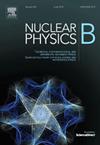Relational quantum geometry
IF 2.8
3区 物理与天体物理
Q2 PHYSICS, PARTICLES & FIELDS
引用次数: 0
Abstract
A common feature of the extended phase space of gauge theory, the crossed product of quantum theory, and quantum reference frames (QRFs) is the adjoining of degrees of freedom followed by a constraining procedure for the resulting total system. Building on previous work, we identify non-commutative or quantum geometry as a mathematical framework which unifies these three objects. We first provide a rigorous account of the extended phase space, and demonstrate that it can be regarded as a classical principal bundle with a Poisson manifold base. We then show that the crossed product is a trivial quantum principal bundle which both substantiates a conjecture on the quantization of the extended phase space and facilitates a relational interpretation. Combining several crossed products with possibly distinct structure groups into a single object, we arrive at a novel definition of a quantum orbifold. We demonstrate that change of frame maps within the quantum orbifold corresponds to quantum gauge transformations, which are QRF preserving maps between crossed product algebras. Finally, we conclude that the quantum orbifold is equivalent to the G-framed algebra proposed in prior work, thereby placing systems containing multiple QRFs squarely in the context of quantum geometry.
关系量子几何
规范理论的扩展相空间、量子理论的交叉积和量子参考系(QRFs)的一个共同特征是自由度的相邻,随后是对所得到的总系统的约束过程。在先前工作的基础上,我们将非交换几何或量子几何确定为统一这三个对象的数学框架。我们首先给出了扩展相空间的严格解释,并证明了它可以被视为具有泊松流形基的经典主束。然后,我们证明交叉积是一个平凡的量子主束,它既证实了关于扩展相空间量子化的猜想,又便于相关解释。将几个可能具有不同结构群的交叉产物组合成一个单一的物体,我们得到了量子轨道的新定义。我们证明了量子轨道内框架映射的变化对应于量子规范变换,量子规范变换是交叉积代数之间的QRF保持映射。最后,我们得出结论,量子轨道与先前工作中提出的g框架代数等效,从而将包含多个qrf的系统完全置于量子几何的背景下。
本文章由计算机程序翻译,如有差异,请以英文原文为准。
求助全文
约1分钟内获得全文
求助全文
来源期刊

Nuclear Physics B
物理-物理:粒子与场物理
CiteScore
5.50
自引率
7.10%
发文量
302
审稿时长
1 months
期刊介绍:
Nuclear Physics B focuses on the domain of high energy physics, quantum field theory, statistical systems, and mathematical physics, and includes four main sections: high energy physics - phenomenology, high energy physics - theory, high energy physics - experiment, and quantum field theory, statistical systems, and mathematical physics. The emphasis is on original research papers (Frontiers Articles or Full Length Articles), but Review Articles are also welcome.
 求助内容:
求助内容: 应助结果提醒方式:
应助结果提醒方式:


